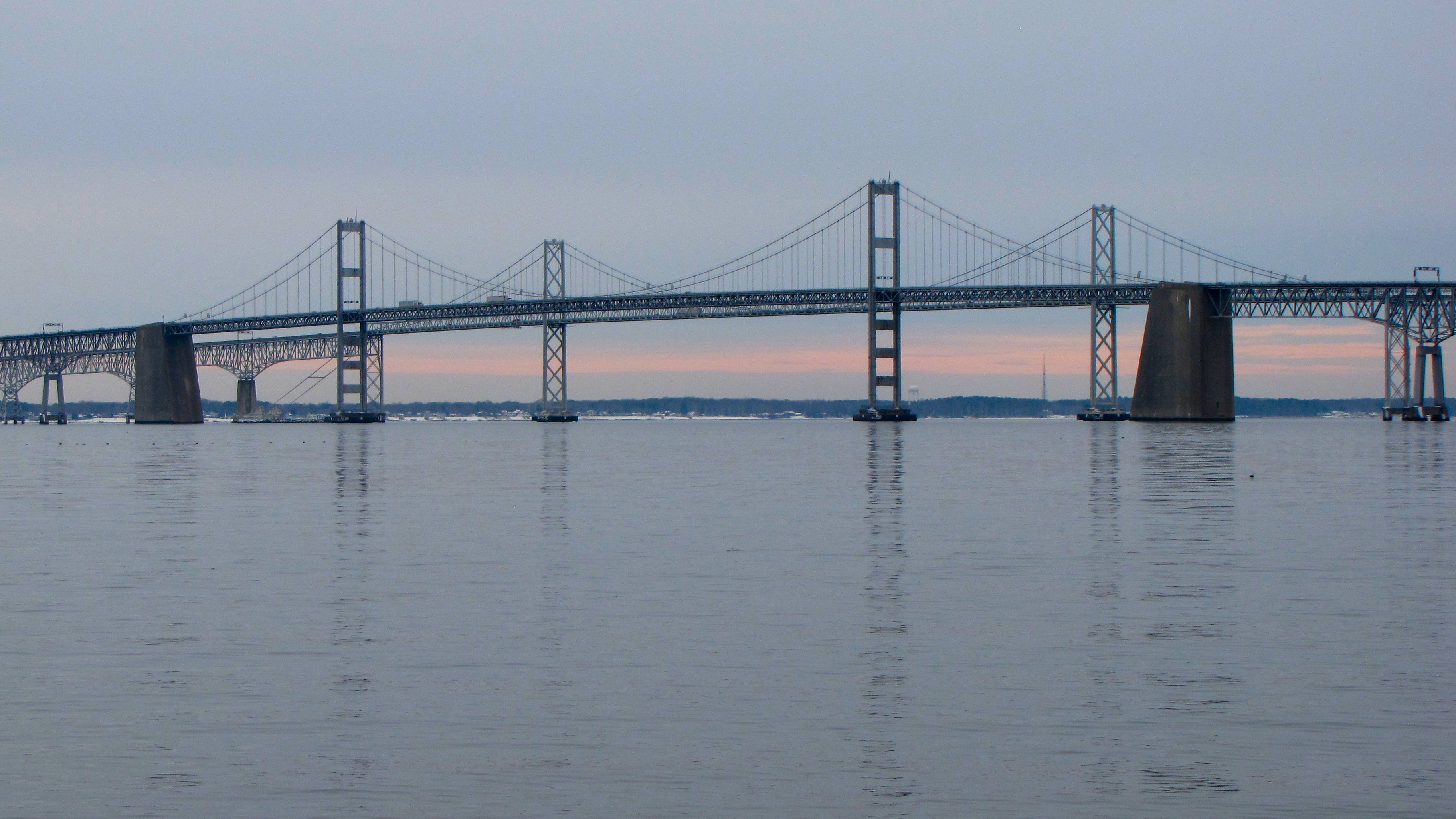User:Michael.shipley
Chesapeake Bay Bridge Project: Structure Art?
Michael Shipley
Professor Schafer
Johns Hopkins: Perspectives in Civil Engineering
This is a practice trial for a personal class assignment and citations and review have not yet been performed or completed

Although the full Chesapeake Bay Bridge is difficult to capture in a single image, the significant changes in structural form are made apparent from this portrayal. At its highest point, one can see the Suspension Steel cable's connected to the subsequent concrete pillars which then relay outward to the steel truss from towards either point of contact.
Overview
The Chesapeake Bay Bridge is an iconic and important structure to most all Marylanders who have ever traveled to the beach or spent significant time in and around the bay. As someone who has grown up on the western side of the bay, the Bay Bridge offers a convenient and significant crossing in what has become an annual tradition of traveling to Ocean City since I was little. It is almost 5 miles long and the tallest point of travel is 186 feet[1]; offering sufficient time for irresistible window watching and a painstaking focus for the driver of any vehicle who fights the urge to look down at the ships and sailboats floating below. As a kid I had the pleasure of frequently sailing under the bridge and the fragile enjoyment of being so close to such an encroachingly massive structure. I clearly remember the way the bridge’s enormous scale would distort my depth perception and one could never help but fear just a little that perhaps the mast of the boat would collide with the huge beams above.
Social
The Chesapeake Bay Bridge, dedicated in memory of the late Governor William Preston Lane, Jr., serves as a social connection between two previously distant parts of Maryland. The Eastern Shore and the Western Shore, now divided only by the bridge and water, was previously two completely separate cultures. While the east was much more rural and agriculturally focused, it’s citizens could only reach the urban West of Baltimore and D.C. by a series of ferry and boat rides. The bridge has provided such social importance, that the eastern point of contact in Queen Anne’s County has now been included as part of the Baltimore- Washington Metropolitan Area proving its ease of access as essential to the neighboring regions.
Scientific
The 2 separate bridges (first built in 1952, and a mirror expansion with an extra lane built in 1973) carry 5 lanes of adjustable traffic over 22,790 feet of steel and concrete in varying engineering forms. Its longest span is 1,600 feet with a clearance of 186 feet. The bridge has a toll for eastbound travelers of $4.00 for single axle vehicles and experiences traffic of 61,000 vehicles per day with an expected 40% increase by 2040. Both bridges were designed by J.E. Greiner Company, which is now part of URS Corporation. It has two main spans over the bays two shipping channels of 3,200-foot suspension spans and a through- truss cantilever span over the subsequent eastern channel with a clearance of 58 feet. As the shores are approached, the bridge takes a deck truss and steel gird span form followed by a concrete beam span and a curve near the western terminus to allow crossing at the channels to be made at a 90 degree angle as in accordance with the United States Army Corps of Engineers requirements. The structure has become economically efficient in state funding and employment opportunities while expanding surrounding economic activity to immediate locations and beyond to further Ocean City and Baltimore City expenditures as well.
Symbolic
The Chesapeake Bay Bridge is an iconic and widely recognized symbol of Maryland to most all local and surrounding residents. Upon construction, it was the longest continuous over- water steel structure and third longest bridge in the world. It has served as starting points for such famous sailing races as the Volvo Ocean Race, and is viewable on clear days from extreme distances way north in the Chesapeake above Pool’s Island and distant South beyond St. Michaels. It is a notable checkpoint when traveling to or from the beach in any road trip and can serve as great fishing locations for local fisherman.
Structures in Comparison
In comparing this structure to others of significant similar features, it is difficult to find one that encompasses such a wide variety of engineering form. The Golden Gate Bridge links to remote locations and provides great symbolism for its city yet fails in length and remains a suspension bridge through point to point. The best comparison for this bridge is the Governor Malcom Wilson Tappan Zee Bridge which has similarities ranging from origination to construction and even down to it’s given name. The bridge in New York stretches the Hudson River and is similar in length at 16,013 feet, clearance at 138 feet, material used as steel, and even the toll cost which is $5.00. It too curves on one end and is a central point of crossing for much traffic over the Hudson River serving the local economies and a symbol of the engineering achievements of its time.
